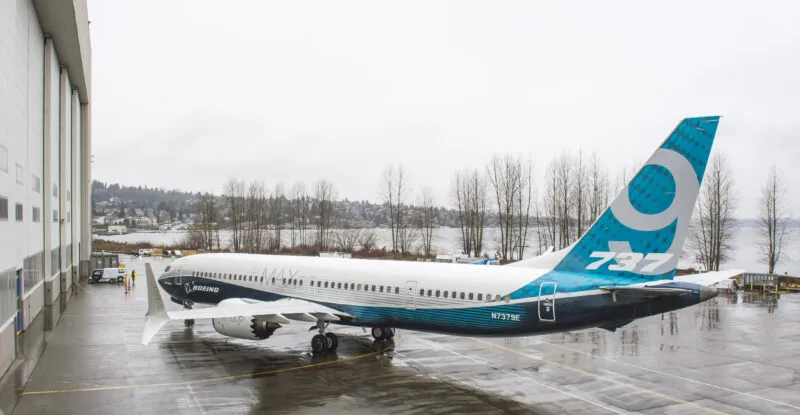Boeing president and CEO Kelly Ortberg is cautiously optimistic the US airframer will be able to increase its 737 MAX production rate to 42 aircraft per month by the end of the year if the Federal Aviation Administration gives it the green light, as key performance indicators (KPIs) suggest Boeing is getting back on track with the 737 MAX program.
Following the 5 January 2024 mid-air blowout of a door plug on an Alaska Airlines 737 MAX 9, the FAA put the brakes on Boeing’s production expansion by imposing a cap of 38 737 MAX twinjets per month and vowing not to approve a production increase “until we are satisfied that the quality control issues uncovered during this process are resolved.”
With its growth stymied, Boeing got to work to fix the fundamental issues that arguably first came to light years earlier following two 737 MAX crashes. According to Ortberg, who joined the airframer in August 2024, Boeing Commercial Airplanes’ (BCA) team “has done a really nice job of implementing the safety and quality plan that is a part of our commitment to improve the product and the safety of our system. And it’s the commitment we have to the FAA.”
“That plan is on track,” he told Morgan Stanley aerospace & defense analyst Kristine Liway during the Morgan Stanley Laguna Conference on 11 September. “They’re implementing it on schedule. So, I feel real good about that.”
In a testimony to the hard work that Ortberg and his team have undertaken, Boeing reached the FAA-imposed production rate of 38 MAX twinjets per month in May of this year. The OEM has six major KPIs that it uses to track the stability of the production system, including a KPI that gauges the amount of rework required on undelivered MAX twinjets. The FAA is using those KPIs to determine if a rate increase is justified, Ortberg said, adding:
We got one KPI that we’ve been bouncing between ‘green’ and a little bit ‘below green,’ which is rework… We see that progressing well.
So, I feel pretty confident that we’ll be in a position here pretty soon to sit down with the FAA and go through what we call a capstone review, which is the process we go through to not just go through these KPIs, but to look at our entire supply chain readiness, our continued production readiness, and move forward with that.
Boeing recently successfully completed a capstone review on the 787 program, enabling it to move from a production rate of five 787s per month to seven per month in the past quarter. “We used the exact same process with the FAA and successfully went through that,” Ortberg noted, giving him hope that the 737 MAX capstone review will glean a positive result.
“You’ve probably heard” FAA Administrator Bryan Bedford, “say things like, ‘we’re going to be doing some tabletop reviews.’ And we have been doing some tabletop reviews with them. So, I think we’re pretty aligned. We’ve got to get this final metric stabilized, and then we’re certainly still planning to be producing at 42 a month by the end of the year.”
The airframer is still grappling with the impact of the door plug blow-out, however. Last Friday, the FAA slapped Boeing with proposed fines of over $3.1 million for safety violations that occurred from September 2023 through February 2024, including actions related to the door plug incident.
If Boeing receives the FAA’s blessing, and bolsters 737 MAX production by a further five aircraft per month by year-end, its supply chain — including passenger experience stakeholders — must be ready for the increase. Some suppliers have in fact been delivering at a higher rate than 38 per month; indeed, some are already at 42 in many cases, and Boeing is accepting those shipments.
“[S]o we clearly have excessive inventories, particularly on our MAX production, and we’ll be utilizing that inventory,” Ortberg said. This paradigm provides some cushion to Boeing as it looks to ramp up production.
“Inventory is going to buffer, even if we do have any supply chain challenges,” he said, though he doesn’t see any major supply chain constraints affecting a boost in production to 42 MAX per month at the Renton factory in Washington.
Boeing has more rate increases in its plan, should it meet the KPIs and pass muster with the FAA. “We’ll go from 42 and then we’ll go up another five, and we’ll go up another five,” Ortberg said.
Whilst Boeing has delivered 737 MAX 8 and MAX 9 twinjets for several years, the smaller 737 MAX 7 variant and the stretched MAX 10 programs are delayed as Boeing works through engine anti-icing solutions for the types, as first reported by The Air Current. But Ortberg reaffirmed at the conference that Boeing expects to obtain certification and start deliveries next year.
Related Articles:
- Lots to like in Icelandair Saga Premium aboard the 737 MAX
- Excitement builds for Boeing 777X as cabin video goes viral
- Boeing explores new cabin branding tech and aesthetics integration
- Astronics raises 2025 guidance on strength of aerospace business
- Southwest Airlines to have 26 jets fitted with cockpit barriers by year-end
Featured image credited to Boeing












